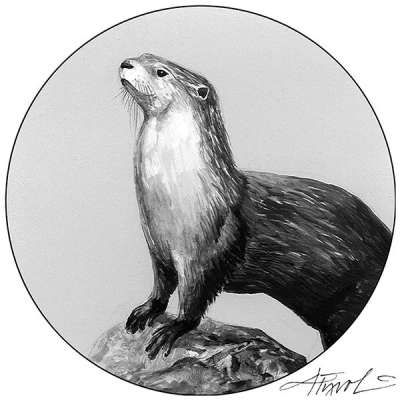
We slid our canoe over the beaver dam and paddled into the upper, smaller pond. A breeze rippled the water and rustled the reeds lining the shore. Suddenly I spied four long, sleek brown figures cavorting in the water ― otters! They submerged quickly near the shore, probably into an old beaver bank den with an underwater entrance. This was one of only a few times in my life I’d seen these secretive, often nocturnal, creatures.
We had likely seen an otter family ― mother and young, known as kits. Once the kits were able to swim well enough, at about three months of age, the family would leave this pond and assume a nomadic lifestyle.
River otters follow a circuitous route through lakes, ponds, and waterways around their home range. Naturalists theorize that if they stayed in one place, otters would deplete populations of their prey ― fish, crayfish, frogs, and shellfish. They travel one- to four-week circuits ― some as long as 20 miles, crossing land as well as water.
Highly social animals, otters communicate with other members of their species as they travel. They do this through scent-marking. Olfactory messages are posted regularly at the same places along a circuit. These “latrine sites” are near the bank of a stream or pond, often at the intersection of two bodies of water, such as where a stream flows into a river. They may also be found on points of land or prominent objects such as abandoned beaver lodges. At these spots, otters roll on the ground, matting down vegetation. They scrape up absorbent materials, squirt urine, and defecate.
Like other members of the weasel family, otters have well-developed anal scent glands at the base of their tails. Their feces or “spraints” (the British term) are anointed with scent from these glands which conveys information to other otters.
You can recognize latrine sites by their flattened vegetation, numerous piles of scat, and fishy odor (or just look where your dog is rolling). Otter scat is easily identified by its scattered appearance and the fish scales, bones, and crayfish parts it contains. Also look for twists of grass and mounds of leaves, mosses, or pine needles.
Otters will mark mounds with scent from the plantar pad glands on their hind feet. Each plantar pad, located in the center of the foot, has four glands. Wildlife expert Susan Morse was the first to deduce the function of these foot glands when she observed otters gathering absorbent materials and shaping them with their hind feet.
During her 38 years of field research in northwestern Vermont, Morse has found that otters tend to scent-mark under big pines or hemlocks, spots often free of snow in winter. “Their goal in creating mounds,” she said, “is to maximize the dispersal of their scent by the wind.” She has also seen otters mark existing piles, such as large anthills, with feces and plantar pad gland scent. (According to Morse, river otters have specific places where they haul out of the water to dry their fur, roll, groom, and sun themselves, and these are not always the same as latrine sites.)
What kinds of messages do otters leave for fellow otters by scent-marking? Biologists believe they communicate individual and species identity and reproductive and social status. Radio telemetry studies of otters in the wild have shown that the home ranges of individuals overlap, so otters are not strictly territorial. However, olfactory messages may allow otters to space out their use of waterways and food resources over time.
Otter latrines can turn up in unexpected places― in populated areas and near small ponds in backyards. These sites are useful to wildlife biologists monitoring otter populations. A study that placed game cameras at otter latrines observed peaks in scent-marking in the spring and fall. The spring peak was attributed to communication with others during the breeding season, and the fall peak to family groups travelling together.
Otters usually visited these sites at night, dawn, or dusk. You can watch a family of otters scent-marking and rolling in the sand along a river at night here.


Discussion *